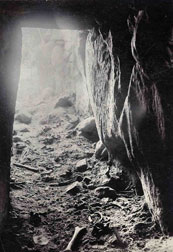How did the burials take place?
In the long barrows one or more people were buried in a wooden burial chamber. The long barrows were succeeded by dolmens. The oldest dolmen chambers, made of large granite blocks, were smaller than their successors. The chamber was closed by laying the top stone over it. Later the chambers grew larger and a passage was added. Perhaps the deceased were only placed in the burial chamber after their skin and flesh had decomposed. This was the custom of the contemporary Neolithic population in northern Germany, where it has been possible in several cases to document that it was skeletons, not whole bodies, that were entombed. We have an example of the bodies being moved around in a dolmen at Trekroner, west of Copenhagen, where five adults and five children were buried. However, no complete skeletons were present and the children were mainly represented by their lower jaws.

A large amount of human bones were found on the floor when the passage grave Rævehøj on western Zealand was excavated in 1914.
The passage graves were used for burials over long periods. The first burials were often removed or disturbed to make room for new ones. In some cases where it has been possible to investigate burials in passage graves, skeletons seem to have been mixed chaotically. In the passage grave Rævehøj in western Zealand at least 100 individuals were buried, and heaps of skulls lay up against one wall of the chamber. Although the skeletons in the passage graves are often split up, there was a method to the madness – they presumably represent complex funeral rituals. Perhaps the passage graves, like the dolmens, were used as a kind of ‘charnel house’, where the bones of ancestors were kept after they had decomposed somewhere else. This might explain why so many skeletons are split up.


A look out from the inside of the double passage grave Troldstuerne in the district of Odsherred. The floor of the passage is covered with various types of human bones.
